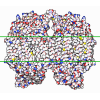[English] 日本語
 Yorodumi
Yorodumi- PDB-7qho: Cytochrome bcc-aa3 supercomplex (respiratory supercomplex III2/IV... -
+ Open data
Open data
- Basic information
Basic information
| Entry | Database: PDB / ID: 7qho | ||||||||||||||||||
|---|---|---|---|---|---|---|---|---|---|---|---|---|---|---|---|---|---|---|---|
| Title | Cytochrome bcc-aa3 supercomplex (respiratory supercomplex III2/IV2) from Corynebacterium glutamicum (as isolated) | ||||||||||||||||||
 Components Components |
| ||||||||||||||||||
 Keywords Keywords | OXIDOREDUCTASE / supercomplex / respiratory chain / cytochrome bcc-aa3 supercomplex / proton translocation / bioenergetics / membrane protein / electron transport | ||||||||||||||||||
| Function / homology |  Function and homology information Function and homology informationthiamine biosynthetic process / aerobic electron transport chain / cytochrome-c oxidase / oxidative phosphorylation / quinol-cytochrome-c reductase / quinol-cytochrome-c reductase activity / cytochrome-c oxidase activity / electron transport coupled proton transport / oxidoreductase activity, acting on paired donors, with incorporation or reduction of molecular oxygen / ATP synthesis coupled electron transport ...thiamine biosynthetic process / aerobic electron transport chain / cytochrome-c oxidase / oxidative phosphorylation / quinol-cytochrome-c reductase / quinol-cytochrome-c reductase activity / cytochrome-c oxidase activity / electron transport coupled proton transport / oxidoreductase activity, acting on paired donors, with incorporation or reduction of molecular oxygen / ATP synthesis coupled electron transport / respiratory electron transport chain / monooxygenase activity / electron transport chain / 2 iron, 2 sulfur cluster binding / iron ion binding / copper ion binding / heme binding / metal ion binding / membrane / plasma membrane Similarity search - Function | ||||||||||||||||||
| Biological species |  Corynebacterium glutamicum ATCC 13032 (bacteria) Corynebacterium glutamicum ATCC 13032 (bacteria) | ||||||||||||||||||
| Method | ELECTRON MICROSCOPY / single particle reconstruction / cryo EM / Resolution: 3.1 Å | ||||||||||||||||||
 Authors Authors | Kao, W.-C. / Hunte, C. | ||||||||||||||||||
| Funding support |  Germany, Germany,  France, 5items France, 5items
| ||||||||||||||||||
 Citation Citation |  Journal: Nat Commun / Year: 2022 Journal: Nat Commun / Year: 2022Title: Structural basis for safe and efficient energy conversion in a respiratory supercomplex. Authors: Wei-Chun Kao / Claire Ortmann de Percin Northumberland / Tat Cheung Cheng / Julio Ortiz / Alexandre Durand / Ottilie von Loeffelholz / Oliver Schilling / Martin L Biniossek / Bruno P Klaholz / Carola Hunte /   Abstract: Proton-translocating respiratory complexes assemble into supercomplexes that are proposed to increase the efficiency of energy conversion and limit the production of harmful reactive oxygen species ...Proton-translocating respiratory complexes assemble into supercomplexes that are proposed to increase the efficiency of energy conversion and limit the production of harmful reactive oxygen species during aerobic cellular respiration. Cytochrome bc complexes and cytochrome aa oxidases are major drivers of the proton motive force that fuels ATP generation via respiration, but how wasteful electron- and proton transfer is controlled to enhance safety and efficiency in the context of supercomplexes is not known. Here, we address this question with the 2.8 Å resolution cryo-EM structure of the cytochrome bcc-aa (III-IV) supercomplex from the actinobacterium Corynebacterium glutamicum. Menaquinone, substrate mimics, lycopene, an unexpected Q site, dioxygen, proton transfer routes, and conformational states of key protonable residues are resolved. Our results show how safe and efficient energy conversion is achieved in a respiratory supercomplex through controlled electron and proton transfer. The structure may guide the rational design of drugs against actinobacteria that cause diphtheria and tuberculosis. | ||||||||||||||||||
| History |
|
- Structure visualization
Structure visualization
| Structure viewer | Molecule:  Molmil Molmil Jmol/JSmol Jmol/JSmol |
|---|
- Downloads & links
Downloads & links
- Download
Download
| PDBx/mmCIF format |  7qho.cif.gz 7qho.cif.gz | 2 MB | Display |  PDBx/mmCIF format PDBx/mmCIF format |
|---|---|---|---|---|
| PDB format |  pdb7qho.ent.gz pdb7qho.ent.gz | 1.6 MB | Display |  PDB format PDB format |
| PDBx/mmJSON format |  7qho.json.gz 7qho.json.gz | Tree view |  PDBx/mmJSON format PDBx/mmJSON format | |
| Others |  Other downloads Other downloads |
-Validation report
| Summary document |  7qho_validation.pdf.gz 7qho_validation.pdf.gz | 4.2 MB | Display |  wwPDB validaton report wwPDB validaton report |
|---|---|---|---|---|
| Full document |  7qho_full_validation.pdf.gz 7qho_full_validation.pdf.gz | 4.2 MB | Display | |
| Data in XML |  7qho_validation.xml.gz 7qho_validation.xml.gz | 160.7 KB | Display | |
| Data in CIF |  7qho_validation.cif.gz 7qho_validation.cif.gz | 231.8 KB | Display | |
| Arichive directory |  https://data.pdbj.org/pub/pdb/validation_reports/qh/7qho https://data.pdbj.org/pub/pdb/validation_reports/qh/7qho ftp://data.pdbj.org/pub/pdb/validation_reports/qh/7qho ftp://data.pdbj.org/pub/pdb/validation_reports/qh/7qho | HTTPS FTP |
-Related structure data
| Related structure data |  13977MC  7qhmC M: map data used to model this data C: citing same article ( |
|---|---|
| Similar structure data | Similarity search - Function & homology  F&H Search F&H Search |
- Links
Links
- Assembly
Assembly
| Deposited unit | 
|
|---|---|
| 1 |
|
- Components
Components
-Protein , 4 types, 8 molecules ANGTKXMZ
| #1: Protein | Mass: 45232.207 Da / Num. of mol.: 2 Source method: isolated from a genetically manipulated source Source: (gene. exp.)  Corynebacterium glutamicum ATCC 13032 (bacteria) Corynebacterium glutamicum ATCC 13032 (bacteria)Strain: ATCC 13032 / DSM 20300 / BCRC 11384 / JCM 1318 / LMG 3730 / NCIMB 10025 Gene: qcrA, Cgl2190, cg2404 Production host:  Corynebacterium glutamicum ATCC 13032 (bacteria) Corynebacterium glutamicum ATCC 13032 (bacteria)References: UniProt: Q79VE8 #7: Protein | Mass: 15557.285 Da / Num. of mol.: 2 Source method: isolated from a genetically manipulated source Source: (gene. exp.)  Corynebacterium glutamicum ATCC 13032 (bacteria) Corynebacterium glutamicum ATCC 13032 (bacteria)Strain: ATCC 13032 / DSM 20300 / BCRC 11384 / JCM 1318 / LMG 3730 / NCIMB 10025 Gene: ctaF, Cgl2194, cg2408 Production host:  Corynebacterium glutamicum ATCC 13032 (bacteria) Corynebacterium glutamicum ATCC 13032 (bacteria)References: UniProt: Q8NNK3, cytochrome-c oxidase #11: Protein | Mass: 8373.271 Da / Num. of mol.: 2 Source method: isolated from a genetically manipulated source Source: (gene. exp.)  Corynebacterium glutamicum ATCC 13032 (bacteria) Corynebacterium glutamicum ATCC 13032 (bacteria)Strain: ATCC 13032 / DSM 20300 / BCRC 11384 / JCM 1318 / LMG 3730 / NCIMB 10025 Gene: Cgl0818 Production host:  Corynebacterium glutamicum ATCC 13032 (bacteria) Corynebacterium glutamicum ATCC 13032 (bacteria)References: UniProt: Q8NS61 #13: Protein | Mass: 17152.379 Da / Num. of mol.: 2 Source method: isolated from a genetically manipulated source Source: (gene. exp.)  Corynebacterium glutamicum ATCC 13032 (bacteria) Corynebacterium glutamicum ATCC 13032 (bacteria)Strain: ATCC 13032 / DSM 20300 / BCRC 11384 / JCM 1318 / LMG 3730 / NCIMB 10025 Gene: thiX, Cgl2332, cg2561 Production host:  Corynebacterium glutamicum ATCC 13032 (bacteria) Corynebacterium glutamicum ATCC 13032 (bacteria)References: UniProt: P42461 |
|---|
-Cytochrome bc1 complex cytochrome ... , 2 types, 4 molecules BOCP
| #2: Protein | Mass: 59863.699 Da / Num. of mol.: 2 Source method: isolated from a genetically manipulated source Source: (gene. exp.)  Corynebacterium glutamicum ATCC 13032 (bacteria) Corynebacterium glutamicum ATCC 13032 (bacteria)Gene: qcrB, Cgl2189, cg2403 Production host:  Corynebacterium glutamicum ATCC 13032 (bacteria) Corynebacterium glutamicum ATCC 13032 (bacteria)References: UniProt: Q79VE9, quinol-cytochrome-c reductase #3: Protein | Mass: 29898.850 Da / Num. of mol.: 2 Source method: isolated from a genetically manipulated source Source: (gene. exp.)  Corynebacterium glutamicum ATCC 13032 (bacteria) Corynebacterium glutamicum ATCC 13032 (bacteria)Strain: ATCC 13032 / DSM 20300 / BCRC 11384 / JCM 1318 / LMG 3730 / NCIMB 10025 Gene: qcrC, Cgl2191, cg2405 Production host:  Corynebacterium glutamicum ATCC 13032 (bacteria) Corynebacterium glutamicum ATCC 13032 (bacteria)References: UniProt: Q8NNK5, quinol-cytochrome-c reductase |
|---|
-Cytochrome c oxidase subunit ... , 3 types, 6 molecules DQERFS
| #4: Protein | Mass: 66340.164 Da / Num. of mol.: 2 Source method: isolated from a genetically manipulated source Source: (gene. exp.)  Corynebacterium glutamicum ATCC 13032 (bacteria) Corynebacterium glutamicum ATCC 13032 (bacteria)Strain: ATCC 13032 / DSM 20300 / BCRC 11384 / JCM 1318 / LMG 3730 / NCIMB 10025 Gene: ctaD, Cgl2523, cg2780 Production host:  Corynebacterium glutamicum ATCC 13032 (bacteria) Corynebacterium glutamicum ATCC 13032 (bacteria)References: UniProt: Q79VD7, cytochrome-c oxidase #5: Protein | Mass: 36811.105 Da / Num. of mol.: 2 Source method: isolated from a genetically manipulated source Source: (gene. exp.)  Corynebacterium glutamicum ATCC 13032 (bacteria) Corynebacterium glutamicum ATCC 13032 (bacteria)Strain: ATCC 13032 / DSM 20300 / BCRC 11384 / JCM 1318 / LMG 3730 / NCIMB 10025 Gene: ctaC, Cgl2195, cg2409 Production host:  Corynebacterium glutamicum ATCC 13032 (bacteria) Corynebacterium glutamicum ATCC 13032 (bacteria)References: UniProt: Q8NNK2, cytochrome-c oxidase #6: Protein | Mass: 22457.217 Da / Num. of mol.: 2 Source method: isolated from a genetically manipulated source Source: (gene. exp.)  Corynebacterium glutamicum ATCC 13032 (bacteria) Corynebacterium glutamicum ATCC 13032 (bacteria)Strain: ATCC 13032 / DSM 20300 / BCRC 11384 / JCM 1318 / LMG 3730 / NCIMB 10025 Gene: ctaE, Cgl2192, cg2406 Production host:  Corynebacterium glutamicum ATCC 13032 (bacteria) Corynebacterium glutamicum ATCC 13032 (bacteria)References: UniProt: Q9AEL8, cytochrome-c oxidase |
|---|
-Uncharacterized ... , 2 types, 4 molecules HUIV
| #8: Protein | Mass: 16954.213 Da / Num. of mol.: 2 Source method: isolated from a genetically manipulated source Source: (gene. exp.)  Corynebacterium glutamicum ATCC 13032 (bacteria) Corynebacterium glutamicum ATCC 13032 (bacteria)Strain: ATCC 13032 / DSM 20300 / BCRC 11384 / JCM 1318 / LMG 3730 / NCIMB 10025 Gene: Cgl2664, cg2949 Production host:  Corynebacterium glutamicum ATCC 13032 (bacteria) Corynebacterium glutamicum ATCC 13032 (bacteria)References: UniProt: Q8NMB4 #9: Protein | Mass: 16385.588 Da / Num. of mol.: 2 Source method: isolated from a genetically manipulated source Source: (gene. exp.)  Corynebacterium glutamicum ATCC 13032 (bacteria) Corynebacterium glutamicum ATCC 13032 (bacteria)Gene: Cgl2017, cg2211 Production host:  Corynebacterium glutamicum ATCC 13032 (bacteria) Corynebacterium glutamicum ATCC 13032 (bacteria)References: UniProt: Q8NP09 |
|---|
-Hypothetical membrane ... , 2 types, 4 molecules JWLY
| #10: Protein | Mass: 12144.160 Da / Num. of mol.: 2 Source method: isolated from a genetically manipulated source Source: (gene. exp.)  Corynebacterium glutamicum ATCC 13032 (bacteria) Corynebacterium glutamicum ATCC 13032 (bacteria)Strain: ATCC 13032 / DSM 20300 / BCRC 11384 / JCM 1318 / LMG 3730 / NCIMB 10025 Gene: Cgl0373 Production host:  Corynebacterium glutamicum ATCC 13032 (bacteria) Corynebacterium glutamicum ATCC 13032 (bacteria)References: UniProt: Q8NTD4 #12: Protein | Mass: 6628.905 Da / Num. of mol.: 2 Source method: isolated from a genetically manipulated source Source: (gene. exp.)  Corynebacterium glutamicum ATCC 13032 (bacteria) Corynebacterium glutamicum ATCC 13032 (bacteria)Strain: ATCC 13032 / DSM 20300 / BCRC 11384 / JCM 1318 / LMG 3730 / NCIMB 10025 Gene: Cgl0673 Production host:  Corynebacterium glutamicum ATCC 13032 (bacteria) Corynebacterium glutamicum ATCC 13032 (bacteria)References: UniProt: Q8NSJ8 |
|---|
-Sugars , 1 types, 2 molecules 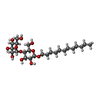
| #22: Sugar |
|---|
-Non-polymers , 19 types, 86 molecules 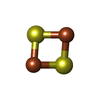
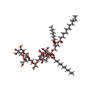
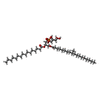
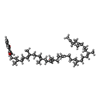
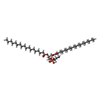

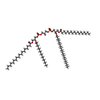

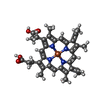
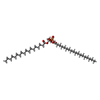
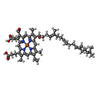
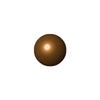


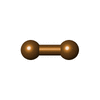


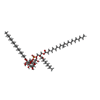



















| #14: Chemical | | #15: Chemical | |
|---|
 Movie
Movie Controller
Controller



 PDBj
PDBj